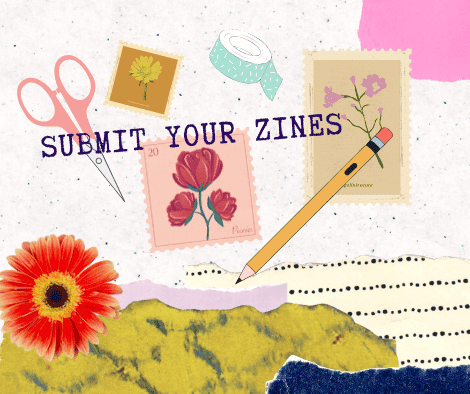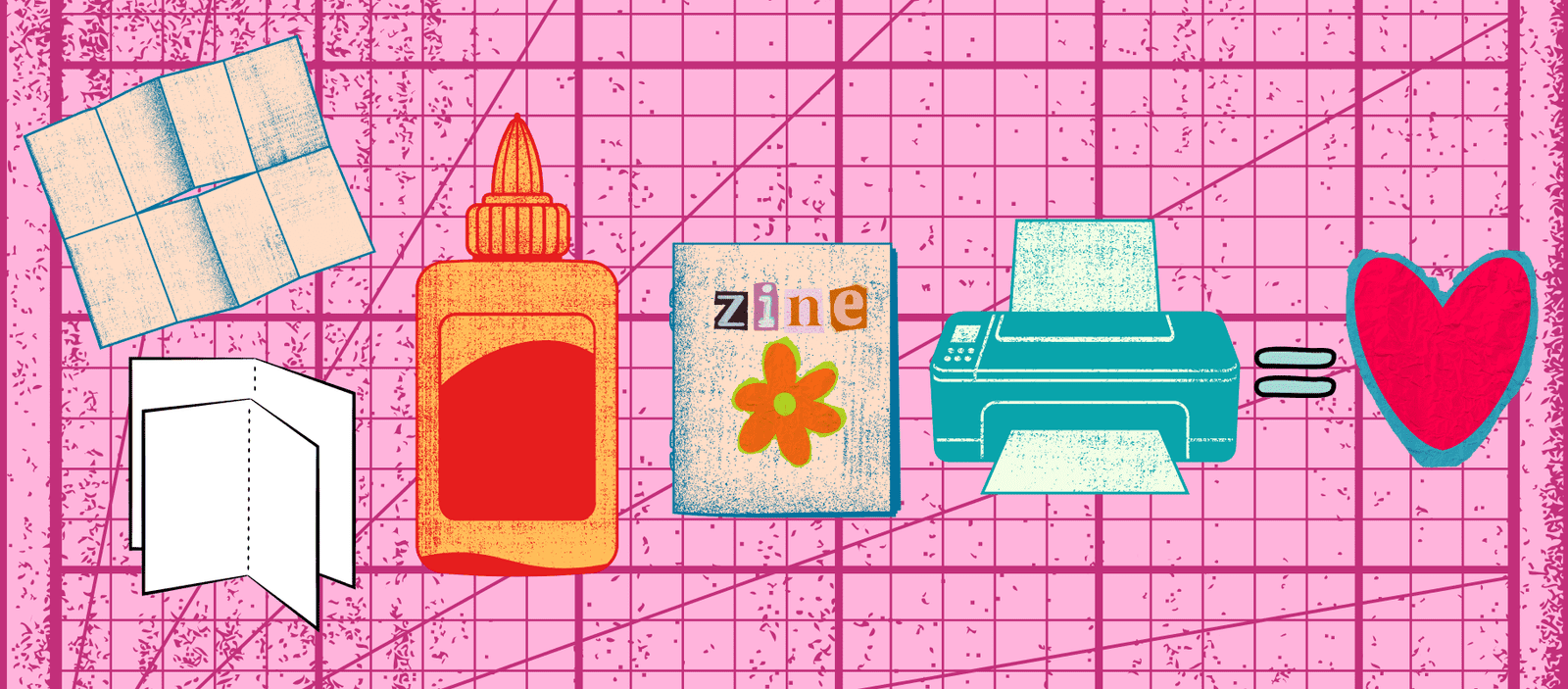Why Digital Zines Matter
Zines have always been about access. They were born in basements, bedrooms, and copy shops because that was where makers had power. No editors, no gatekeepers, no “submit and wait six months” — just scissors, glue, and a Xerox machine that squeaked with every copy.

But here we are, living half our lives online. Screens are our notebooks, timelines are our distribution channels, and the photocopier has been replaced by drag-and-drop export buttons. The spirit of zines hasn’t changed — but the tools have.
Digital zines are what happens when DIY publishing collides with a world of hyperlinks, scrolls, and swipes. They can be PDFs, Instagram carousels, websites, interactive flipbooks, or something we don’t even have a name for yet. They’re the evolution of zine culture, not the replacement. The same scrappy urgency, just in pixels instead of toner.
What Makes a Zine a Zine (Even Online)
Before we start clicking “export,” let’s clear something up. A zine isn’t defined by paper. It’s defined by attitude.
- Self-published. No one’s giving you permission.
- Low-barrier. Cheap (or free) to make, easy to distribute.
- Voice-driven. It sounds like you, not like a press release.
- Community-oriented. It speaks to your people, not to the algorithm.
So even when it lives on a screen, if it feels urgent, personal, messy, and honest, it counts.

Choosing Your Digital Format
Here’s the fun part: you’ve got options.
1. PDF Zines
The classic digital zine format. Export your layouts to a PDF, upload it, and boom — instant zine. Easy to share, easy to download, easy to print if someone wants a physical copy.
Pros: Simple, accessible, printable.
Cons: Static. Doesn’t play well with mobile screens unless you design for them.
2. Flipbook / Page-Turn Zines
Sites like Issuu or Flipsnack let you upload a PDF and turn it into a clickable, page-flipping zine. Perfect if you want that “turn the page” feel without paper cuts.
Pros: Fun to browse, interactive.
Cons: Can feel a little slick. Some platforms lock features behind paywalls.
3. Web Zines
Build your zine as a website (using WordPress, Carrd, Wix, or hand-coded HTML). Each section can be a page, each spread a scroll.
Pros: Infinite possibility — text, audio, video, gifs.
Cons: More setup. Can feel less “zine-y” if it looks too polished.
4. Social Media Zines
Yes, your Instagram carousel or TikTok slideshow can be a zine. Sequence a story across posts, drop art in between, and distribute straight to your followers.
Pros: Immediate reach, instant audience.
Cons: You’re building on rented land. Algorithms eat everything eventually.
5. Hybrid Zines
Why not both? Release a PDF, drop highlights on IG, and archive the whole thing on a simple website. The beauty of digital zines is flexibility — one project can live in multiple forms.
Tools of the Trade
You don’t need to sell your kidney for Adobe. You don’t need ten years of design school. What you do need is curiosity and a few decent tools.
- Layout & Design: Canva (easy, free), Affinity Publisher (cheap, one-time cost), InDesign (industry standard if you can afford it).
- Collage & Illustration: Procreate, Krita (free), Photoshop (if you’re already paying for it).
- Writing & Drafting: Google Docs, Scrivener, Notion, or literally Notes on your phone.
- Distribution: Gumroad (sell), Ko-fi (donate), Substack (serialize), or just a Dropbox link.
The best tool is the one you actually open. Don’t waste months researching. Pick one and start.

Crafting the Digital Aesthetic
Zines are never just about what’s said — they’re about how it looks. But digital layouts have different rules than photocopied paper.
- Think Screen-First. Big fonts. Strong contrasts. No 8-point typefaces.
- Add Motion. GIFs, scrolling effects, embedded videos — things paper can’t do.
- Play with Glitch. Pixelation, low-res scans, VHS filters. Digital doesn’t have to mean clean.
- Leave Traces. Handwriting, doodles, coffee stains — imperfections make it feel human.
- Mix Media. Drop in sound clips, hyperlink references, collage memes with poetry.
Remember: ugly is an aesthetic. Clean is an aesthetic. You get to pick.

Collaboration & Community
Digital zines travel fast. That makes them perfect for collective projects.
- Multi-voice anthologies. Collect pieces from your friends, your group chat, your activist circle.
- Interactive submissions. Ask people to send in voice notes, screenshots, or memes.
- Global reach. Your zine doesn’t just land in your town. It can land anywhere with Wi-Fi.
Zines have always been about community. Going digital just widens the circle.
Distribution: Getting It Out There
Once your zine exists, you need to get it into hands — or onto screens. Options:
- Free download. Upload to Google Drive, Dropbox, or your website. Share the link.
- Pay-what-you-can. Use Gumroad, Itch.io, or Ko-fi. Let people toss a few bucks if they can.
- Subscription model. Drop zines regularly to your Substack or Patreon. Paid readers get first dibs.
- Social snippets. Post teaser spreads on Instagram or TikTok. Drive people to the full download.
Digital distribution isn’t about profit margins; it’s about access. But that doesn’t mean you shouldn’t value your work. Tip jars exist for a reason.
Archiving Your Work
One thing about the internet: it eats itself. Posts vanish. Links rot. Platforms die.
That’s why archiving matters. Always keep a master folder of your zines (finished PDFs, source files, even screenshots). Host them in at least two places: your computer and a cloud backup. If possible, print a few copies — future you will thank you.
Zines are history. Treat them that way.
Digital Zine Ideas to Try
Not sure where to start? Here’s a handful of prompts:
- Screenshot Diaries. Compile a week’s worth of texts, memes, notes, and browser tabs.
- Hyperlink Essay. Write a piece where every sentence links somewhere unexpected.
- Collage Zine. Mix scanned doodles, found images, and typed captions.
- Soundtrack Zine. Embed a playlist or QR codes linking to music.
- Emoji Poetry. Write entirely in emoji. Translate it back later.
- Protest Pack. Templates for posters, social posts, or chants.
- Moodboard Manifesto. A zine that’s 90% visuals, 10% text, all feeling.
The only wrong move is not making one.

The Future of Zines Is Both/And
Here’s the secret: digital zines don’t kill print zines. They amplify them. A PDF can turn into a print run. A website can host a downloadable booklet. An Instagram post can drive someone to a physical distro table.
Zine culture has always been about adaptability. Photocopiers, Risographs, dot-matrix printers — every new tool got folded into the mix. Screens are just the latest in a long line of tools for saying what you need to say, your way.
So don’t pick one. Do both. Drop a digital version and a print run. Let them travel together.
Closing Rally
You don’t need a glossy app or a design degree to make a digital zine. You need an idea, a deadline, and a willingness to make something a little messy.
Open the tool you already have. Draft the words. Drop in the images. Export it. Share it.
That’s all a zine has ever been: proof you showed up. Proof you cared enough to make a thing and push it into the world.
And now, with digital zines, your world just got a whole lot bigger.
If you’d like to check out some examples of digital zines, check out the archives hosted by the Library of Virginia and enjoy the video below for instructions on how to create your first digital zine in Canva.
Ready to make your own digital rebellion? Start your zine, share it, and archive it — because your voice belongs online and in print.
→ Subscribe to The Edit
→ Submit Your Work
→ Follow @shezinemagazine

AXO (she/her) is a multidisciplinary creator, editor, and builder of feminist media ecosystems based in Toronto. She is the founder of She Zine Mag, Side Project Distro, BBLGM Club, and several other projects under the AXO&Co umbrella — each rooted in DIY culture, creative rebellion, and community care. Her work explores the intersection of craft, technology, and consciousness, with an emphasis on handmade ethics, neurodivergent creativity, and the politics of making. She is an advocate for accessible creativity and the power of small-scale cultural production to spark social change. Her practice merges punk, print, and digital media while refusing to separate the emotional from the practical. Above all, her work invites others to build creative lives that are thoughtful, defiant, and deeply handmade.

























